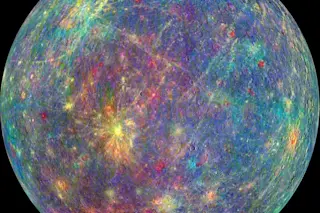This colorful version of Mercury was assembled from spectral data taken with the MESSENGER spacecraft, highlighting various minerals on the planet's surface. (Credit: NASA/Johns Hopkins University Applied Physics Laboratory/Carnegie Institution of Washington) New data is throwing our theories about Mercury's formation into disarray. Scientists already knew that Mercury looked a bit odd inside. The planet is 60 percent core by volume. Earth is just 15-17 percent core. The crust and mantle on Mercury combined reach only about 250 miles deep into its 1,500 mile radius — Earth’s mantle alone is 1,800 miles thick. Now, new research published in Earth and Planetary Science Letters examines data from NASA’s Mercury orbiter MESSENGER to come to new conclusions about our innermost planet. The planet’s crust may be as much as 25 percent more dense than we’d thought—which could muddy the picture of how Mercury came to be.
One of the more popular theories ...














